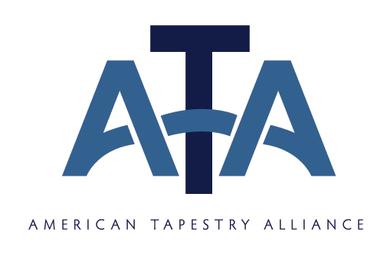
Silvia Heyden
Weaving Dance, 2006
35 in x 41 in

Silvia Heyden
Rhythmic Tapestry, 2011
48 in x 36 in
In Memory of Silvia Heyden, 1927-2015
As I look back over my eighty years of sketching, seventy-five years of playing the violin and sixty years of weaving tapestries, I clearly see the confluence of strings in my work that has made musical themes of rhythm, motifs, movement, repetition and variation the key to my compositions. When I play my violin, I see the visual interpretation on the loom of musical pieces; when I am weaving, I listen to the inner rhythm of the forms and colors as my tapestry evolves. In my decades at the loom, I have never copied images, but rather have sought to let the patterns emerge organically as dictated by the process of weaving. Instead of superimposing a form to be woven on the weft, I have always looked with my ‘loomish’ eyes to see what the weft and warp would allow me to execute. As a result of experimenting with different techniques, I have over the years taken the basic elements of triangles, slits, and half-rounds to uncharted new territory, creating feathered weave, rounded slits, and sculpted bands. I aim to weave tapestries that are uniquely textile in nature and fully live up to the expressive potential of weaving, showing, for example, the texture of different colored threads in a way no painter could paint.
The impact of music on my tapestries can be seen in the dynamic tension built up and then released between forms and colors; in fact, many of my compositions follow the musical progression of allegro, largo, and vivace in a sonata, all while striving to keep the movement within the outline of the tapestry. My fingers improvise on the loom to bring out motifs and make them vibrate in the colors I combine before resolving the tension again. I am fascinated by the parallels between the strings of my violin and of my loom and often feel that after sixty years of exploration, I have only just begun to discover what is unique about weaving a tapestry.

Silvia Heyden
Crescendo in Mixed Threads, 2012
36 in x 43 in
Silvia Heyden’s Biography
Born in Basel, Switzerland, in 1927, Silvia Heyden began her artistic career drawing and playing the violin at an early age. Her childhood dream to build violins was thwarted because girls at that time were not accepted as apprentices for violin-makers, so instead, she practiced her violin all the more passionately. She studied textiles at the School of Arts in Zurich, directed by Johannes Itten in the Bauhaus tradition, under Elsi Giauque from 1948-1953. She won the Achievement Award of the City of Zurich. In 1954, Silvia married Dr. Siegfried Heyden and spent the following years with her daughter Françoise and son Daniel in Philadelphia, Berlin, and Zurich. When she was given a large commission for the Expo-Suisse in Lausanne, Switzerland in 1962, she bought her first upright tapestry loom and experimented with different weaving techniques in numerous tapestries. In 1965, Silvia completed another large commission for the Gimnasio di Locarno in Switzerland. Following her husband’s new position as a Professor of Medicine at Duke University, the family moved to Durham, NC in 1966. Here she continued to explore new forms of weaving, refine her modern compositions in hundreds of abstract tapestries, and play the violin with local orchestras. This fusion of weaving and music culminated in 1968 when she created a 100’ x 10’ commission for the Bankers Trust Company in New York entitled “Sonata with a Castle Theme in Three Movements.”
Silvia had her first major exhibit at the Duke University Museum of Art in 1972, followed by numerous other exhibits in the US, Switzerland, and Germany. Between 1973 and 1993 she completed a number of major commissions, the most important one of which was for the Concert Hall of the City of Bremen, Germany, in 1977, called “Die Glocke” or “The Bell.” Her move back to Switzerland, this time to the Italian part on the Lago Maggiore in 1993, led her to play with the String Orchestra of Locarno and to an important exhibition at the Textile Museum of St. Gallen in 1994 and then the Palazzo Oppesso in Turin, Italy in 1999. In 2002 she completed a tapestry for the Town Hall in San Nazzaro, Switzerland before moving back to Durham, NC in 2005. Her series of tapestries inspired by her walks along the local Eno River was the subject of Kenny Dalsheimer’s acclaimed hour-long documentary entitled “A Weaverly Path” in 2011.
